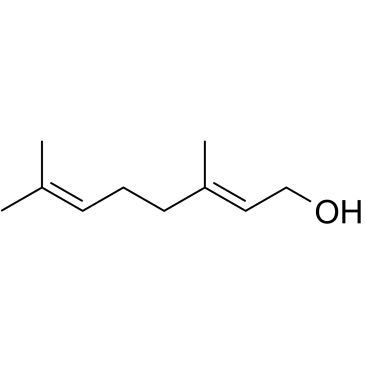香叶醇; (E)-3,7-二甲基-2,6-辛二烯-1-醇

香叶醇; (E)-3,7-二甲基-2,6-辛二烯-1-醇结构式

|
常用名 | 香叶醇; (E)-3,7-二甲基-2,6-辛二烯-1-醇 | 英文名 | Geraniol |
|---|---|---|---|---|
| CAS号 | 106-24-1 | 分子量 | 154.249 | |
| 密度 | 0.9±0.1 g/cm3 | 沸点 | 229.5±0.0 °C at 760 mmHg | |
| 分子式 | C10H18O | 熔点 | -15 °C | |
| MSDS | 中文版 美版 | 闪点 | 76.7±0.0 °C | |
| 符号 |


GHS05, GHS07 |
信号词 | Danger |
|
Differential expression of small RNAs under chemical stress and fed-batch fermentation in E. coli.
BMC Genomics 16 , 1051, (2015) Bacterial small RNAs (sRNAs) are recognized as posttranscriptional regulators involved in the control of bacterial lifestyle and adaptation to stressful conditions. Although chemical stress due to the toxicity of precursor and product compounds is frequently ... |
|
|
Capturing of the monoterpene olefin limonene produced in Saccharomyces cerevisiae.
Yeast , doi:10.1002/yea.3038, (2014) Monoterpene olefins such as limonene are plant compounds with applications as flavouring and fragrance agents, as solvents and potentially also in polymer and fuel chemistry. We engineered baker's yeast Saccharomyces cerevisiae to express a (-)-limonene synth... |
|
|
Identification of olfactory receptor neurons in Uraba lugens (Lepidoptera: Nolidae) and its implications for host range.
J. Insect Physiol. 78 , 33-46, (2015) Phytophagous insects detect volatile compounds produced by host and non-host plants, using species-specific sets of olfactory receptor neurons (ORNs). To investigate the relationship between the range of host plants and the profile of ORNs, single sensillum r... |
|
|
Surfactants, aromatic and isoprenoid compounds, and fatty acid biosynthesis inhibitors suppress Staphylococcus aureus production of toxic shock syndrome toxin 1.
Antimicrob. Agents Chemother. 53 , 1898-906, (2009) Menstrual toxic shock syndrome is a rare but potentially life-threatening illness manifest through the actions of Staphylococcus aureus toxic shock syndrome toxin 1 (TSST-1). Previous studies have shown that tampon additives can influence staphylococcal TSST-... |
|
|
Volatile Compounds from Grape Skin, Juice and Wine from Five Interspecific Hybrid Grape Cultivars Grown in Québec (Canada) for Wine Production.
Molecules 20 , 10980-1016, (2015) Developed from crosses between Vitis vinifera and North American Vitis species, interspecific hybrid grape varieties are becoming economically significant in northern areas, where they are now extensively grown for wine production. However, the varietal diffe... |
|
|
Comparison of Aroma-Active Volatiles in Oolong Tea Infusions Using GC-Olfactometry, GC-FPD, and GC-MS.
J. Agric. Food Chem. 63 , 7499-510, (2015) The aroma profile of oolong tea infusions (Dongdingwulong, DDWL; Tieguanyin, TGY; Dahongpao, DHP) were investigated in this study. Gas chromatography-olfactometry (GC-O) with the method of aroma intensity (AI) was employed to investigate the aroma-active comp... |
|
|
Circuit formation and function in the olfactory bulb of mice with reduced spontaneous afferent activity.
J. Neurosci. 35(1) , 146-60, (2015) The type of neuronal activity required for circuit development is a matter of significant debate. We addressed this issue by analyzing the topographic organization of the olfactory bulb in transgenic mice engineered to have very little afferent spontaneous ac... |
|
|
Phytochemical analysis and in vitro biological activity of three Hypericum species from the Canary Islands (Hypericum reflexum, Hypericum canariense and Hypericum grandifolium).
Fitoterapia 100 , 95-109, (2015) In the present work we carried out a phytochemical and biological investigation on three Hypericum species, i.e. Hypericum reflexum, Hypericum canariense and Hypericum grandifolium, from the Canary Islands where they are traditionally used as diuretic, wound ... |
|
|
Cell-based microfluidic platform for mimicking human olfactory system.
Biosens. Bioelectron. 74 , 554-61, (2015) Various attempts have been made to mimic the human olfactory system using human olfactory receptors (hORs). In particular, OR-expressed cell-based odorant detection systems mimic the smell sensing mechanism of humans, as they exploit endogenous cellular signa... |
|
|
Two types of alcohol dehydrogenase from Perilla can form citral and perillaldehyde.
Phytochemistry 104 , 12-20, (2014) Studies on the biosynthesis of oil compounds in Perilla will help in understanding regulatory systems of secondary metabolites and in elucidating reaction mechanisms for natural product synthesis. In this study, two types of alcohol dehydrogenases, an aldo-ke... |